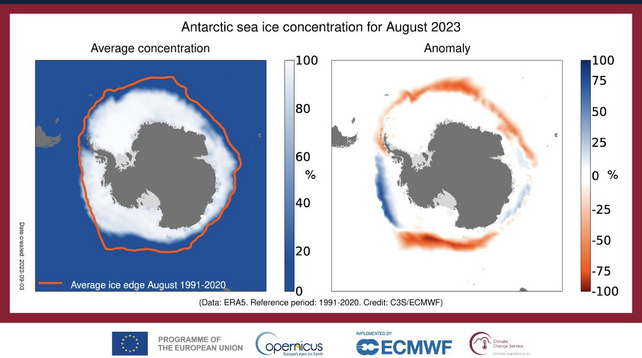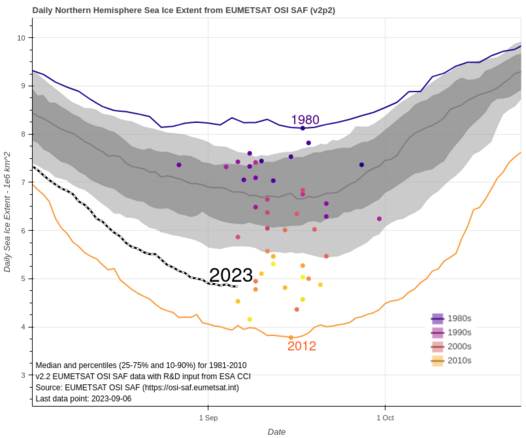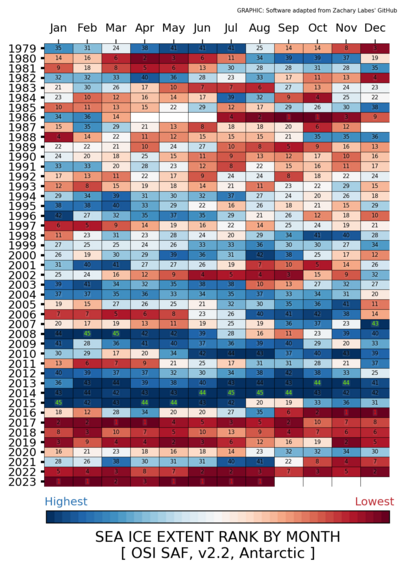Lars Kaleschke · @seaice
779 followers · 481 posts · Server det.socialNew preprint available
Kaleschke, L., Tian-Kunze, X., Hendricks, S., and Ricker, R.: SMOS-derived Antarctic thin sea-ice thickness: data description and validation in the Weddell Sea, Earth Syst. Sci. Data Discuss. [preprint], https://doi.org/10.5194/essd-2023-326, in review, 2023.
#Antarctic #SeaIce #RemoteSensing #SMOS #OpenScience #OpenData #OpenAccess
#antarctic #seaice #remotesensing #SMOS #openscience #opendata #openaccess
Dr Sam Burgess 🌊 🌍 💸 · @OceanTerra
964 followers · 279 posts · Server fediscience.orgAugust #SeaIce highlights from #C3S:
❄️ #Antarctic sea ice saw the largest negative anomaly for August on record, at 12% below average;
❄️ #Arctic sea ice was 10% below average but well above the record minimum from August 2012.
#CopernicusClimate #Climate #seaice #Reanalysis #climatecrisis #Antarctic
#climatecrisis #Reanalysis #Climate #CopernicusClimate #arctic #Antarctic #C3S #seaice
Rick Thoman · @AlaskaWx
2210 followers · 2055 posts · Server alaskan.socialSea ice extent in the seas north of Alaska is approaching the seasonal minimum. As of September 9, both the East Siberian Sea and Beaufort Sea #SeaIce extent was the 3rd lowest past 45 years, Chukchi Sea at 6th lowest in NSIDC data. New ice isn't going to form south of 74N in the next week but the remaining ice will be pushed around by the wind and waves action will continue to melt some ice even as solar heating is rapidly waning. #akwx #Arctic
@Climatologist49 @ZLabe
Rick Thoman · @AlaskaWx
2205 followers · 2035 posts · Server alaskan.socialUpdated 50-year change in summer average temperature in and around the #Arctic, now for 1974 through 2023, using ERA5 courtesy of ECMWF/Copernicus. Virtually all land areas are warming, with the largest increases over northern Siberia and parts of northern Canada. Large increases over some ocean areas directly related to #SeaIce loss. Higher Arctic ocean areas show little change as heating goes into melting snow/ice through most of the summer. #ClimateChange #ClimateCrisis
@Climatologist49
#arctic #seaice #climatechange #climatecrisis
Lars Kaleschke · @seaice
778 followers · 478 posts · Server det.socialPolarstern reaches North Pole
#Fensterfreitag #Arctic #SeaIce #Climate
https://www.awi.de/en/about-us/service/press/single-view/polarstern-erreicht-nordpol.html
#Fensterfreitag #arctic #seaice #climate
SigneAaboe · @SigneAaboe
240 followers · 350 posts · Server fediscience.orgNorobiik @Norobiik@noc.social · @Norobiik
484 followers · 7578 posts · Server noc.socialThe research, published in the journal Nature Climate Change, found #Antarctica was warming at a rate of between 0.22C and 0.32C per decade, compared to 0.18C per decade predicted by climate models. #ClimateCrisis #SeaIce
Antarctica warming much faster than models predicted in ‘deeply concerning’ sign for sea levels | Antarctica | The Guardian
https://www.theguardian.com/world/2023/sep/08/antarctica-warming-much-faster-than-models-predicted-in-deeply-concerning-sign-for-sea-levels
#seaice #climatecrisis #antarctica
Marte Hofsteenge · @martehofsteenge
108 followers · 4 posts · Server vis.socialCheck out little article about some #printmaking artwork I did related to our science project for the Antarctic Science Platform ⬇️🎨🇦🇶
#seaice #scicomm #sciart #printmaking
SigneAaboe · @SigneAaboe
240 followers · 350 posts · Server fediscience.orgNo surprise. But still crazy.
#Antarctic #SeaIce extent is low.
This graphic shows the ranking of sea-ice extent by month. Take a look at the last line (representing 2023 and updated including August).
Lars Kaleschke · @seaice
775 followers · 469 posts · Server det.socialThe latest drop of #Antarctic #SeaIce extent seen in my plots is of course not real but an artefact due to missing #JAXA satellite data. I received the following messages:
Malfunction of the product upload system for G-Portal was occurred at 02:05UTC on August 30th, 2023...
We'll continue manual registration for further products, but the situation might remain for a while...
Rick Thoman · @AlaskaWx
2192 followers · 1947 posts · Server alaskan.socialArctic-wide #SeaIce extent as of September 1 was lower than any point in 2021 or 2022 in NSIDC passive microwave data. The 2023 minimum extent is likely a week or two away. Graphic courtesy NSIDC.
2021 min: 4.77 million km²
2022 min: 4.70 million km²
Sept 1, 2023: 4.67 million km²
#seaice #arctic #climatechange
Rick Thoman · @AlaskaWx
2190 followers · 1944 posts · Server alaskan.socialSea ice extent in the Beaufort Sea (north of Alaska, northwest Canada) has now dipped to less than 200,000 km² in NSIDC data for only the third year in the satellite era (since 1979). Extent is likely to decrease a little bit more in the coming days as a storm with moderate southeast winds and waves impacts #SeaIce in the western Beaufort Sea late Sunday/Monday. #akwx #Arctic @Climatologist49 @ZLabe
Thomas Lavergne · @lavergnetho
1143 followers · 833 posts · Server fediscience.orgI wrote down some thoughts about the cmocean.ice colormap that many of us use to plot maps of #SeaIce.
https://github.com/matplotlib/cmocean/issues/93
And I invite the #SeaIce community to join the discussion 😅
Illustration: a map of sea-ice concentration with 3 different colormaps (cmocean's ice, matplotlib's Blues_r, and matplotlib's PuBu_r)
@ZLabe @SigneAaboe @AlaskaWx @seaice and all...
Thomas Lavergne · @lavergnetho
1140 followers · 828 posts · Server fediscience.org#Arctic #SeaIce extent was 9th lowest in August (#OSISAF).
With only 2 weeks left of the melt season, we are not heading towards a record minimum this year.
Still, the 📉 trend is clear: since 1978, #satellites recorded an average loss of 70,000 km2 of ice *per year*.
#satellites #osisaf #seaice #arctic
Thomas Lavergne · @lavergnetho
1139 followers · 825 posts · Server fediscience.org📢 #Antarctic #SeaIce extent was *record low* in August according to #osisaf
We are missing 2 millions km2 of sea ice compared to the 1981-2010 climatology.
The end of winter is approaching in the #Antarctic: soon the Sun will warm the ocean and melt the ice 😭 .
Ruth Mottram · @Ruth_Mottram
7378 followers · 10824 posts · Server fediscience.orgThe ferry I am currently on has just passed the #PenguinsFPSO a floating storage and production operations vessel that, #Shell assures us here, "is an attractive opportunity with a competitive forward looking price".
And all I can think of is the paper I commented on last week about emperor penguin chicks that failed to fledge because the #SeaIce around #Antarctica broke up early.
#FossilFuels #OilAndGas #ClimateChange #EmperorPenguins
#emperorpenguins #climatechange #OilandGas #fossilfuels #antarctica #seaice #shell #penguinsfpso
PJ Coffey · @Homebrewandhacking
1576 followers · 14485 posts · Server mastodon.ieImportant thread attached.
https://fediscience.org/@PoLaRobs/110975123418693370
@PoLaRobs - A thread about the extreme anomaly in Antarctic sea-ice extent this year, the present state of knowledge on the reasons for it and why further research is important.
I find the sharp downward trend in Antarctic sea-ice extent that started 7 years ago deeply unsettling, which is why I toot about it a lot.
1/n
#antarctic #science #climatechange #seaice
Ruth Mottram · @Ruth_Mottram
7370 followers · 10777 posts · Server fediscience.orgPolar Remote Sensing, Bremen · @PolarBremen
40 followers · 15 posts · Server mas.toIntroducing Maxi, a space sciences 🪐 master's student and our newest member! Currently exploring #Sentinel1 data to study oil seeps in the Arctic 🛰️ 🛢️ ❄️ Using #machinelearning in 🐍 to classify oilspills in #seaice conditions. In early stages, focused on data preprocessing. 🌊
#seaice #machinelearning #Sentinel1
Rick Thoman · @AlaskaWx
2172 followers · 1837 posts · Server alaskan.socialSea ice continues to melt away in the seas north of Alaska. In the northwest Beaufort Sea there's now open water to 76ºN in NWS Alaska Region #SeaIce concentration analysis (right). Chukchi Sea ice extent well below even the 1991-2020 median and is now 90 percent open water in NSIDC data (left). #akwx #Arctic
@Climatologist49 @ZLabe















